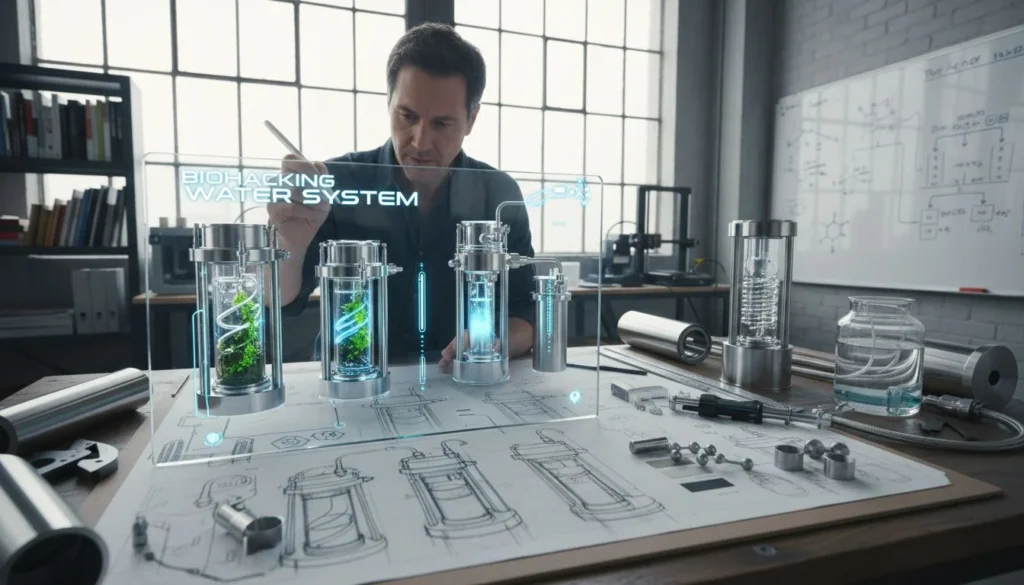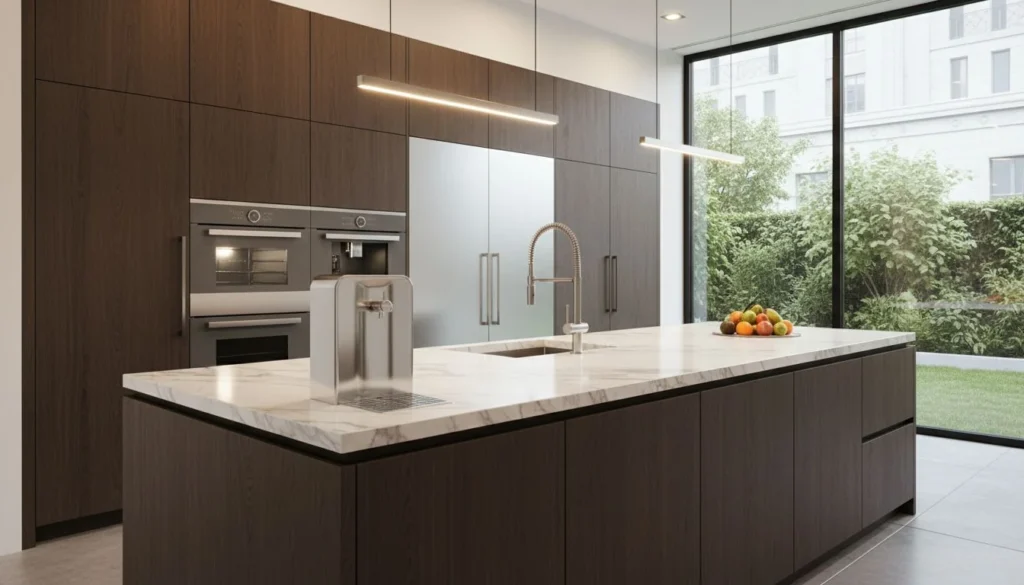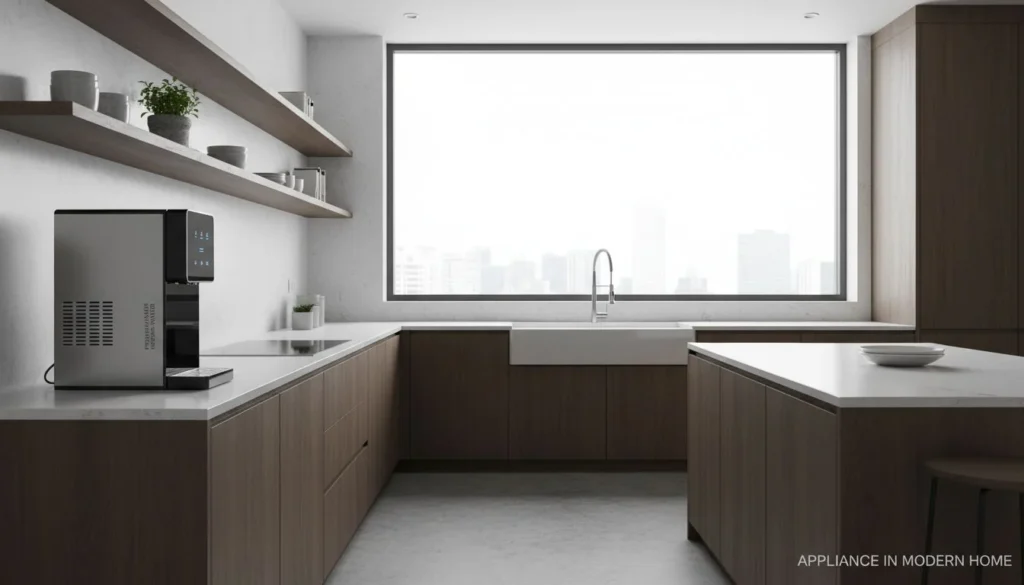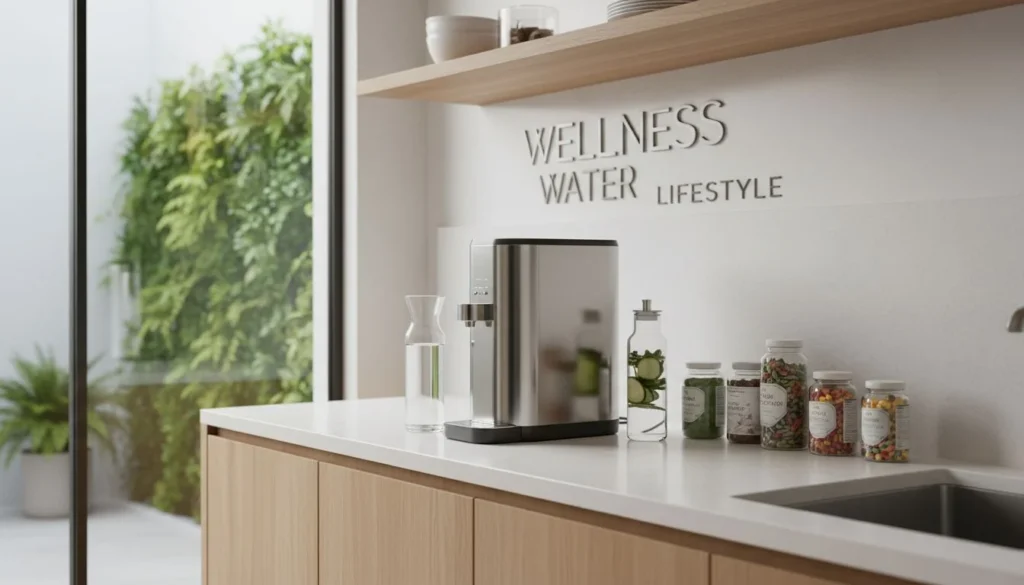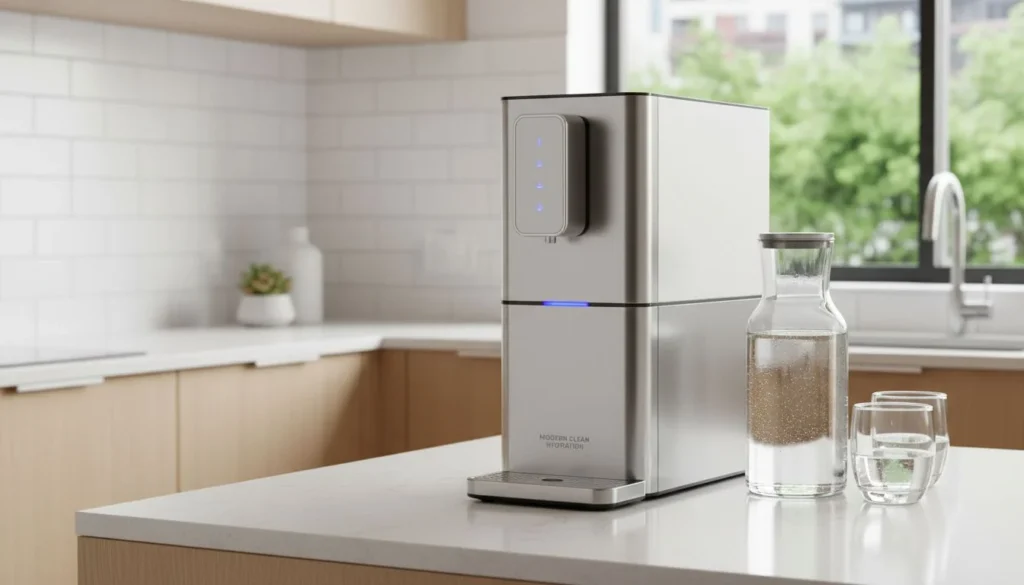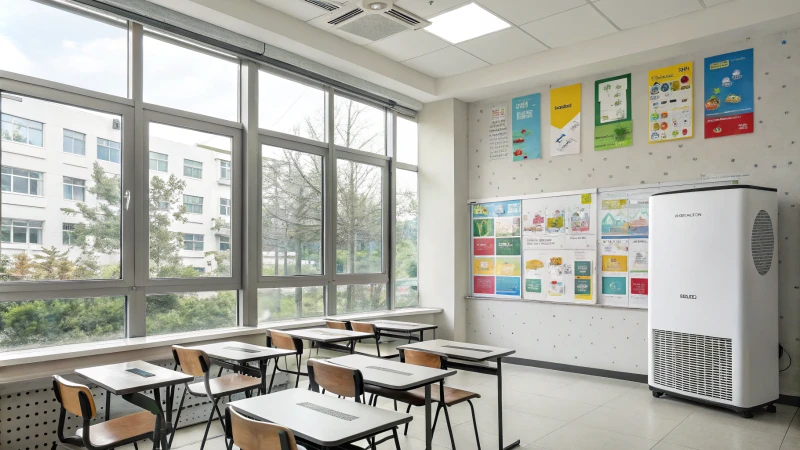
Piense en ese momento de la escuela en el que todos querían relajarse y concentrarse en los estudios.
El mejor purificador de aire para colegios necesita filtros resistentes y un funcionamiento silencioso. También debe tener un diseño que impida que los niños lo toquen. Los modelos HisoAir son una gran opción. Su avanzada tecnología es impresionante. Se instalan silenciosamente en paredes o techos. Ideales para colegios.
Recordando mi época escolar, el ruido nos distraía mucho del aprendizaje. Los purificadores de aire adecuados no sólo ayudan a limpiar el aire, sino también a crear espacios silenciosos. Elegir un purificador de aire para un aula significa fijarse en su eficacia, sobre todo en las aulas grandes, donde el aire fresco es muy importante para la salud. El tamaño y el sonido del purificador también importan. Un purificador de aire silencioso que limpie bien el aire cambia mucho el aula.
A algunos alumnos les encanta tocar todo lo que ven. Por eso son muy útiles las unidades montadas en la pared o en el techo. Estas unidades permanecen fuera de su alcance, por lo que trabajan sin interrupciones. Empresas como HisoAir conocen estas necesidades. Ofrecen soluciones que combinan un buen rendimiento con un diseño inteligente. HisoAir desarrolla purificadores que funcionan bien y pasan desapercibidos, probablemente la mejor opción para las escuelas.
Las aulas necesitan purificadores de aire con más de 300 CFM.Verdadero
A menudo, las aulas superan los 1.000 pies cuadrados y requieren entre 5 y 6 intercambios de aire.
Los purificadores HisoAir no son adecuados para las escuelas.Falso
HisoAir ofrece purificadores silenciosos y de alto rendimiento ideales para escuelas.
¿Qué características debe buscar en un purificador de aire para aulas?
¿Ha entrado alguna vez en una clase y ha notado que el aire parece viciado? Este aire viciado no sólo es desagradable, sino que constituye un riesgo para la salud.
Elija un purificador de aire con características clave para un aula. Entre los factores importantes se incluyen una elevada tasa de suministro de aire limpio (CADR) y bajos niveles de ruido. La verdadera filtración HEPA garantiza un aire limpio. Las opciones de instalación segura importan mucho. Estas opciones ayudan a crear un lugar tranquilo para el aprendizaje.
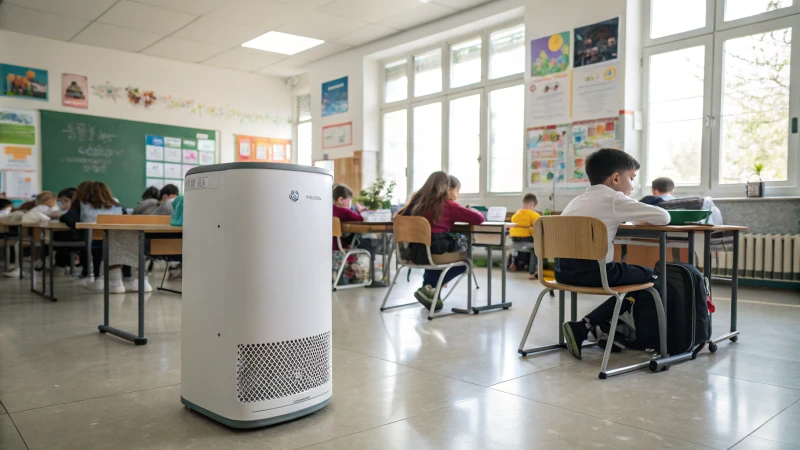
Importancia de la tasa de suministro de aire limpio (CADR)
Recuerdo la primera vez que entré en la clase de mi hija. El aire parecía pesado. Las ventanas cerradas impedían que entrara el frío, pero se notaban muchas respiraciones en el interior. Esto me hizo darme cuenta de lo importante que es una buena calidad del aire. Los niños pasan mucho tiempo en estos espacios.
Lo primero que aprendí fue sobre la tasa de suministro de aire limpio (CADR). Esta tasa muestra cuánto aire limpio suministra un purificador cada minuto. Los lugares grandes, como las aulas, lo necesitan. Los espacios de más de 1000 pies cuadrados requieren un CADR superior a 300 CFM para mantener el aire fresco y fácil de respirar.
Sistemas de filtración: True HEPA y más
Otro factor importante es el sistema de filtración. Los verdaderos filtros HEPA son de primera categoría, ya que capturan el 99,97% de partículas diminutas de hasta 0,3 micras, lo que ayuda a atrapar alérgenos y virus.
| Tipo de filtro | Función |
|---|---|
| Verdadero HEPA | Captura partículas diminutas |
| Carbón activado | Elimina olores y COV |
| Prefiltro | Atrapa las partículas más grandes |
Algunos purificadores también utilizan filtros de carbón activado para tratar los olores y los productos químicos, lo que supone una gran ventaja.
Niveles de ruido: Silencio significa concentración
Intentar concentrarse con ruido de fondo es difícil. En las aulas, los niveles de ruido son importantes. He descubierto que los purificadores con niveles de ruido inferiores a 50 decibelios funcionan mejor para mantener la concentración en entornos educativos.
Consideraciones sobre seguridad e instalación
La seguridad me preocupa mucho. Los niños podrían tocar el aparato, por lo que montar purificadores en paredes o techos es inteligente. Ahorra espacio y crea un ambiente más seguro para todos, lo que beneficia tanto a los niños como a los profesores.
Características adicionales a tener en cuenta
Los purificadores modernos cuentan con funciones adicionales como sensores de calidad del aire y modos automáticos que ajustan la configuración del purificador en función de las condiciones actuales, lo que proporciona facilidad y comodidad, algo increíblemente útil para cualquier profesor.
Los purificadores de aire para aulas necesitan más de 300 CFM para ser eficaces.Verdadero
Para lograr 5-6 intercambios de aire por hora en espacios grandes, se necesitan 300 CFM.
Decibel Cancellation™ de HisoAir es una tecnología de reducción del ruido.Verdadero
Decibel Cancellation™ reduce el ruido, mejorando el entorno de aprendizaje.
¿Cómo afecta el nivel de ruido a los entornos de aprendizaje?
¿Has estudiado alguna vez cerca de una obra? Es parecido a estudiar en un concierto de rock a todo volumen. El ruido distrae y frustra. Es un verdadero reto para los estudiantes que quieren concentrarse.
Los niveles de ruido afectan mucho a los espacios de aprendizaje. Perturban la concentración y la comprensión. El ruido elevado reduce el rendimiento académico. Los niveles de estrés aumentan. Las estrategias de control del ruido son realmente útiles. Mejoran los resultados del aprendizaje.
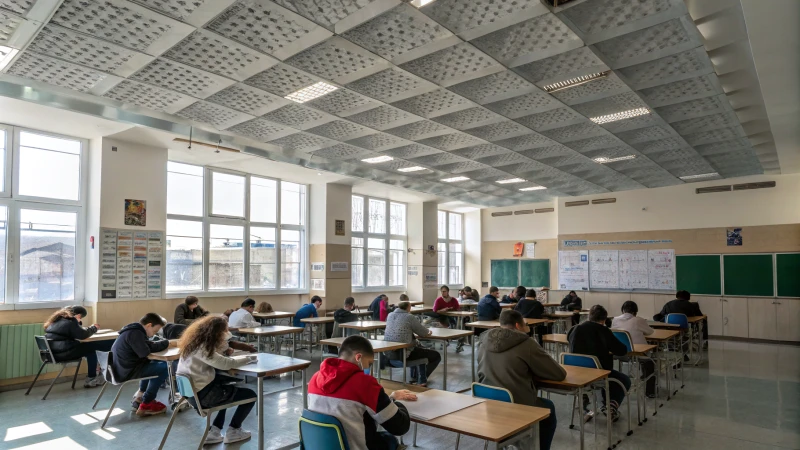
La ciencia detrás del ruido
Un día estaba sentado en clase, intentando escuchar una lección importante. El ruido del tráfico y de la gente que hablaba cerca de una ventana era más alto que el del profesor. Era como escuchar un susurro en medio de una tormenta. Los estudios demuestran que demasiado ruido, como charla de fondo1 o el tráfico, provoca sobrecarga mental. A los alumnos les cuesta entender las lecciones y recordar cosas. Un entorno más tranquilo favorece la concentración y mejora el aprendizaje.
Efectos psicológicos del ruido en las aulas
El ruido provoca un verdadero estrés mental. He visto a estudiantes estresados y ansiosos por las aulas ruidosas. Yo también lo he sentido: una espesa niebla mental. Los niveles altos de ruido perjudican la salud mental y pueden incluso causar problemas físicos que impidan el aprendizaje. Aplicar soluciones de amortiguación del ruido, como alfombras, cortinas o paneles acústicos, puede ayudar a mitigar estos efectos.
Evaluación de la acústica de las aulas
¿Has gritado alguna vez por el ruidoso aire acondicionado de una clase? No es nada divertido. Comprobar cómo viaja el sonido en un aula es muy importante. Un buen Relación señal/ruido2 ayuda a los alumnos a oír las clases con claridad. Herramientas como los decibelímetros pueden medir los niveles de ruido ambiente y ayudar a los educadores a identificar las zonas problemáticas.
| Fuente de ruido | Impacto potencial | Estrategia de mitigación |
|---|---|---|
| Sonidos de tráfico | Distrae a los alumnos | Instalar ventanas de doble acristalamiento |
| Charla en clase | Reduce la atención | Disponga los asientos estratégicamente |
| Sistemas HVAC | Causa interferencias de audio | Utilizar equipos poco ruidosos |
Estrategias prácticas para reducir el ruido en las aulas
Creación de zonas tranquilas3 en las escuelas lo cambia todo. Estas zonas permiten a los alumnos trabajar sin ser interrumpidos. Los sistemas de enmascaramiento acústico añaden ruido de fondo constante, cubriendo los sonidos molestos y manteniendo la concentración.
Comprender el impacto del ruido en el aprendizaje ayuda a los profesores a crear mejores lugares para los alumnos. La resolución de estos problemas no sólo mejora el aprendizaje, sino que también mejora la educación.
Las aulas necesitan purificadores de aire de más de 300 CFM para ser eficientes.Verdadero
Las aulas requieren purificadores de alto rendimiento para un intercambio de aire adecuado.
Los purificadores montados en la pared no son adecuados para las aulas.Falso
Los purificadores montados en la pared evitan las interferencias de los alumnos y aumentan la seguridad.
¿Por qué es importante la colocación de los purificadores de aire para escuelas?
Recuerdo el momento en que mi escuela recibió su primer purificador de aire. Al principio lo dudé. Comprender la importancia de su ubicación lo cambió todo para mí.
La correcta colocación de los purificadores de aire en las escuelas es importante para mejorar la calidad del aire interior. Los purificadores de aire deben colocarse de forma inteligente. Esto ayuda a que limpien bien el aire. Ayudan a eliminar las partículas nocivas. Una colocación adecuada mejora el flujo de aire. Cubren más espacio en la habitación. Los alérgenos y patógenos se reducen eficazmente.
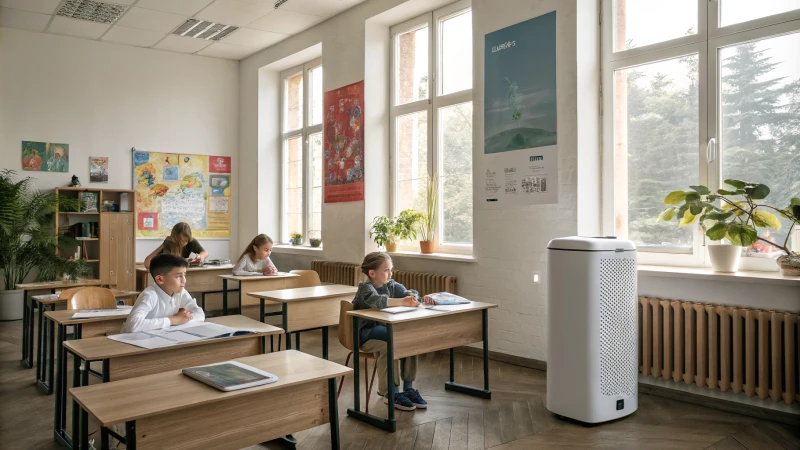
Mejorar el flujo de aire y la cobertura
Recordando mis años en una escuela muy concurrida, me doy cuenta de por qué es importante conocer la dinámica de las aulas. Tomemos un aula de más de 1.000 metros cuadrados. Sin una colocación inteligente, incluso un purificador de aire de primera podría no funcionar bien. Antes creía que bastaba con tener un purificador de aire. Pero la ubicación es crucial. Se necesita una unidad potente con más de 300 CFM para conseguir 5-6 cambios de aire cada hora.
Colocar el purificador en el centro es esencial. Es como colocar un ventilador en el lugar adecuado para enfriar una habitación de manera uniforme. No esconda los purificadores detrás de los muebles o en las esquinas; es como intentar oír un susurro en medio del ruido. Las opciones montadas en la pared los mantienen inteligentemente a salvo de manos curiosas y, además, siguen siendo eficaces.
Control del ruido
El ruido perturba las aulas de forma silenciosa pero segura. Recuerdo la dificultad de concentrarse en medio de los sonidos de los equipos. Las tecnologías como Decibel Cancellation™ son valiosas porque mantienen los purificadores muy silenciosos.
| Característica | Beneficio |
|---|---|
| Diseño mural | Evita la manipulación |
| Decibel Cancellation™ | Reduce el ruido |
Seguridad y protección
La seguridad en las escuelas es muy importante para mí, sobre todo si tenemos en cuenta que los niños pequeños están interesados en explorarlo todo. Las unidades montadas en la pared o en el techo ahorran espacio y alejan la curiosidad.
Mientras investigaba, descubrí unidades con bloqueo para niños. Son pequeños detalles reconfortantes que tranquilizan a los padres y les garantizan la seguridad de los niños en la escuela.
Obtener lo mejor con la tecnología
Encontrar el purificador adecuado parece difícil, pero marcas como HisoAir4 simplificarlo. Sus modelos se adaptan a grandes espacios como las aulas, combinando una filtración superior con un bajo nivel de ruido para lograr un entorno de aprendizaje excelente.
Además, la facilidad de mantenimiento es clave. Los modelos con filtros accesibles agilizan el mantenimiento y prolongan la vida útil del purificador. Dedicar tiempo a encontrar una unidad adecuada merece la pena.
Los purificadores de aire para aulas necesitan más de 300 CFM para ser eficaces.Verdadero
Las normas AHAM recomiendan más de 300 CFM para un intercambio de aire eficaz.
Los purificadores montados en la pared evitan las interferencias de los alumnos en las aulas.Verdadero
El montaje de purificadores en paredes o techos reduce la manipulación por parte de los alumnos.
¿Son adecuados los productos HisoAir para entornos educativos?
¿Le preocupa el aire que respiran sus hijos en el colegio? Descubra cómo los productos HisoAir cambian las aulas con aire limpio y fresco. La salud importa de verdad. El aprendizaje también mejora. Tanto la salud como el aprendizaje se benefician.
Los productos HisoAir encajan perfectamente en colegios e institutos. Limpian el aire a fondo. Las máquinas son silenciosas. La instalación permite diferentes opciones. Estas características crean un entorno saludable. Los estudiantes se concentran mejor. Se mantiene la alta calidad del aire.
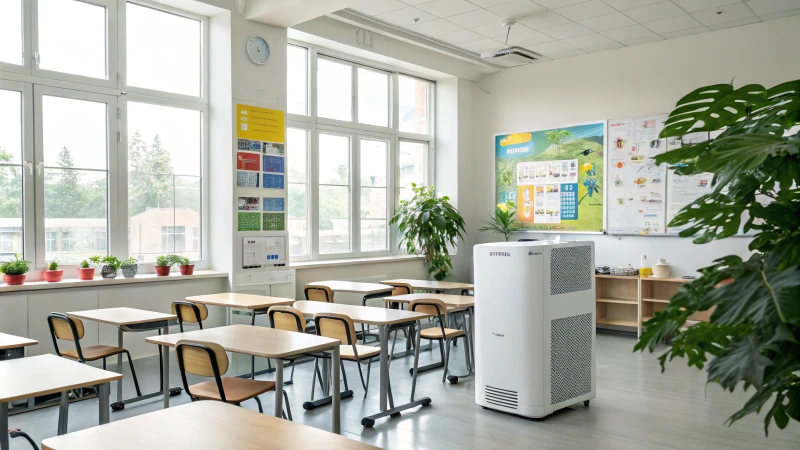
Comprender las necesidades de calidad del aire en las escuelas
Recuerdo que el invierno pasado entré en la clase de mi hijo y sentí que el aire no era fresco. Muchos niños hacinados en una misma aula afectaban a la calidad del aire. Las aulas de los colegios presentan dificultades especiales, como el hecho de tener mucha gente y diferentes tamaños de habitación. HisoAir filtros avanzados5 ayudan a eliminar las partículas nocivas, creando un espacio más saludable para el estudio.
Consideraciones sobre el ruido en los entornos de aprendizaje
Otra cosa que vi fue ruido. Un viejo purificador de aire hacía un ruido fuerte y molesto. La innovadora tecnología Decibel Cancellation™ de HisoAir reduce el ruido, por lo que es ideal para aulas que requieren silencio6. Las aulas silenciosas ayudan a los alumnos a concentrarse mejor. Las aulas que necesitan silencio obtienen grandes beneficios de este invento.
| Característica | Beneficio para las escuelas |
|---|---|
| Gran capacidad de filtración | Elimina alérgenos, polvo y patógenos |
| Funcionamiento silencioso | Favorece la concentración y el aprendizaje |
| Instalación versátil | Se puede montar en la pared o en el techo |
Flexibilidad de instalación
Vi a alumnos jugando con unidades de pie durante una visita escolar. Esto era preocupante. HisoAir ofrece formas flexibles de instalación, como colocar las unidades en la pared o en el techo. Esto evita que los alumnos manipulen las unidades y garantiza un funcionamiento óptimo. distribución del aire7 en grandes espacios.
Comparación de purificadores de aire para colegios
Los centros educativos deben elegir los purificadores de aire teniendo en cuenta puntos clave como la eficacia con la que limpian el aire y el sonido que emiten. Al seleccionar un purificador de aire para un entorno educativo, tenga en cuenta parámetros de rendimiento como la tasa de suministro de aire limpio (CADR) y los niveles de ruido:
| Marca | CADR | Nivel de ruido | Instalación |
|---|---|---|---|
| HisoAir | Alta | Bajo | Pared/Techo |
| Marca X | Medio | Medio | Suelo |
| Marca Y | Bajo | Alta | Limitado |
HisoAir destaca en estas áreas, lo que lo convierte en la mejor opción para mantener un entorno de aprendizaje eficaz y saludable. Pienso en estas características para que la escuela de mi hijo ofrezca a los alumnos el mejor entorno que se merecen.
Los purificadores HisoAir son ideales para las aulas de los colegios.Verdadero
HisoAir ofrece opciones de alto rendimiento, silenciosas y montadas en la pared, adecuadas para escuelas.
Los purificadores residenciales normales bastan para las aulas.Falso
Las aulas requieren mayor CFM y control de ruido que los purificadores residenciales típicos.
Conclusión
Los purificadores de aire HisoAir son ideales para colegios, ya que ofrecen un alto rendimiento, un bajo nivel de ruido y diseños seguros montados en la pared para mejorar la calidad del aire y los entornos de aprendizaje en las aulas.
-
Este enlace explora cómo el ruido de fondo perturba la concentración de los alumnos y ofrece ideas para gestionar esas distracciones. ↩
-
Conozca el papel de la relación señal/ruido en la mejora de la acústica de las aulas para mejorar el aprendizaje. ↩
-
Descubra métodos para establecer zonas tranquilas en las escuelas a fin de mejorar la concentración y reducir la contaminación acústica. ↩
-
Explore por qué los purificadores HisoAir son ideales para entornos escolares, centrándose en sus características de rendimiento y seguridad. ↩
-
Descubra cómo la filtración avanzada mejora la calidad del aire, crucial para reducir alérgenos y patógenos en las aulas. ↩
-
Descubra por qué minimizar el ruido es esencial para mantener la concentración de los alumnos y mejorar los resultados del aprendizaje. ↩
-
Descubra cómo los purificadores montados en la pared o en el techo mejoran la distribución del aire, evitando las interferencias de los alumnos. ↩


